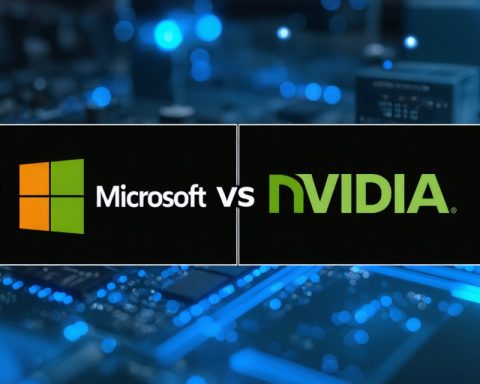- STMicroelectronics N.V. experienced a significant stock decline of nearly 50% in 2024, reflecting semiconductor industry volatility.
- Geopolitical tensions and tightened regulations contributed to growth challenges and increased investor uncertainty.
- The semiconductor market has seen reduced demand in consumer electronics and traditional automotive sectors.
- STMicroelectronics reported a 50% drop in Industrial segment revenue and a 15% decrease in its Automotive division in Q2.
- The Philadelphia Semiconductor Index achieved a 19.2% return but underperformed compared to the S&P 500’s 23% gain.
- Analysts predict potential growth for STMicroelectronics in 2025, driven by a recovering industrial sector and demand for emerging technologies.
- The semiconductor industry faces a crossroads with stagnant legacy markets and growing opportunities in AI and data centers.
- Investors must understand these shifts to capitalize on future growth in the semiconductor sector.
STMicroelectronics N.V., an often-overlooked titan in the semiconductor realm, saw its stock plummet almost by half in 2024, a stark reflection of the industry’s volatile landscape. The year unraveled as a challenging chapter for many semiconductor companies amidst a symphony of geopolitical and economic disruptions. As global tensions escalated, regulations tightened, shackling growth and fanning investor uncertainty. The once-brightly burning beacon of technological prowess found itself dimmed by shrinking demands in the consumer electronics and traditional automotive sectors.
Though the Philadelphia Semiconductor Index showed a decent 19.2% return, it paled next to the broader S&P 500’s impressive 23%. Many semiconductor firms, including STMicroelectronics, were caught on the back foot, unable to ward off the unexpected downturn in their core markets. Lower-than-expected Q2 results dealt a harsh blow to STMicroelectronics—its Industrial segment revenue plummeted by over 50%, while its Automotive division shrank by about 15%.
The outlook felt grim, yet there lingered a whisper of optimism. Analysts, with a cautious stance, spotlighted STMicroelectronics for its potential comeback, suggesting growth acceleration in 2025 due to a recovery in the industrial sector and a resurgence in semiconductor demand for emerging technologies, like the next-generation iPhones.
This turbulence paints a vivid picture of an industry at a crossroads, with a “tale of two markets” emerging. On one hand, there’s the somewhat stagnant territory tied to legacy sectors. On the other, lies the fertile ground of generative AI and advanced data centers, teeming with growth potential. The semiconductor world today is one of shifting paradigms, and the true winners will be those who can successfully navigate this duality. For investors, the key message rings clear: understanding these shifts is crucial to reaping future rewards.
STMicroelectronics: The Semiconductor Giant’s Roller Coaster Journey in 2024 and Beyond
Market Trends and Industry Forecast
In 2024, STMicroelectronics and the broader semiconductor industry faced unprecedented challenges due to geopolitical tensions, tighter regulations, and a decline in consumer electronics demand. However, as the dust begins to settle, several trends and forecasts indicate potential growth avenues:
1. Resurgence in Industrial Applications: With a shift towards automation and smart manufacturing, the industrial segment is poised for recovery. McKinsey predicts the adoption of Industry 4.0 solutions, including IoT devices and smart analytics, will significantly boost semiconductor demand in 2025.
2. Automotive Sector Revival: While traditional automotive markets declined, advancements in electric vehicles (EVs) and autonomous driving technologies present significant new opportunities for semiconductor companies. Gartner forecasts a 25% increase in the demand for automotive semiconductor components by 2026.
3. Emerging Technologies: The demand for semiconductors in AI, machine learning, and quantum computing is expected to surge. Semiconductor chips powering generative AI and advanced data centers are seen as pivotal to future technological advancements.
How-To Steps & Life Hacks for Investors
1. Portfolio Diversification: Investors should consider diversifying their portfolios to include companies involved in both traditional and emerging semiconductor technologies. This can hedge against volatility in any single sector.
2. Stay Informed About Technological Advancements: Keeping abreast of trends like AI, quantum computing, and IoT is crucial. Sites like TechCrunch offer insights into emerging tech trends.
3. Monitor Geopolitical Developments: Global political climates can significantly impact semiconductor markets. Following updates on platforms like BBC News could provide valuable insights.
Real-World Use Cases for STMicroelectronics Products
– Smart Home Devices: STMicroelectronics’ chips are integral to IoT devices, enabling enhanced connectivity and smart solutions for home automation.
– Healthcare Innovations: The firm manufactures sensors and components used in cutting-edge medical devices, supporting telemedicine and remote monitoring advancements.
– Automotive Innovations: Their products are crucial in developing EV capabilities, particularly in battery management systems and vehicle automation technologies.
Reviews & Comparisons
STMicroelectronics finds itself in competition with industry giants like Intel, AMD, and Texas Instruments. While the latter focus heavily on microprocessor advancements, STMicroelectronics continues leveraging its expertise in sensors and application-specific integrated circuits (ASICs). Both Gartner and IDC highlight STMicroelectronics as having strong potential when targeting niche markets in industrial applications.
Controversies & Limitations
The regulatory landscape and sourcing of raw materials for semiconductors pose considerable logistical and ethical challenges. Moreover, the industry’s vulnerability to supply chain disruptions and geopolitical tensions remains a critical concern.
Security & Sustainability
STMicroelectronics is committed to sustainability, following a comprehensive roadmap to reduce environmental impact through efficient resource use and adopting renewable energies. For security, the focus lies in enhancing the security features of IoT devices, addressing privacy concerns amidst growing cybersecurity threats.
Insights & Predictions
Experts predict that as the semiconductor industry adapts to the emerging dual-market landscape, firms like STMicroelectronics could indeed accelerate their growth by leveraging sectors like EVs and AI. This pivot is likely to commence more distinctly in 2025, once immediate geopolitical disruptions stabilize.
Actionable Recommendations for Investors
– Long-Term Investments in Emerging Tech: Focus on the long game by investing in companies positioned to capitalize on AI and automotive advancements.
– Embrace Volatility: Given the sector’s intrinsic volatility, seasoned investors might explore options and derivative markets for better risk management.
– Regular Market Analysis: Stay updated with market analyses and reports from reliable financial news platforms like Bloomberg.
By understanding and capitalizing on these emerging trends and market shifts, investors and industry stakeholders can better navigate the dynamic semiconductor landscape.











